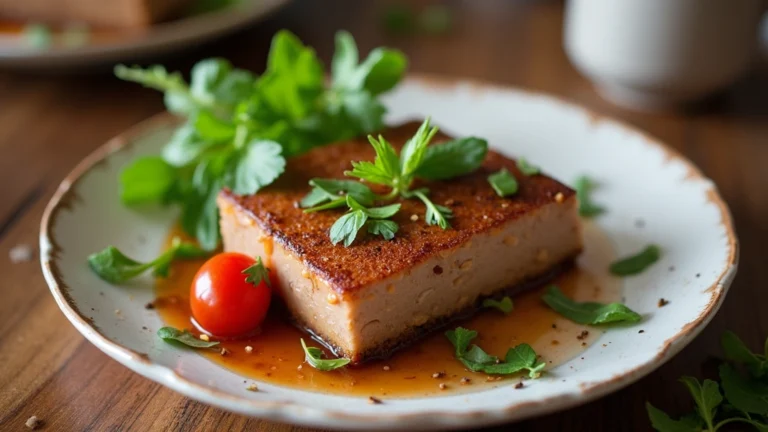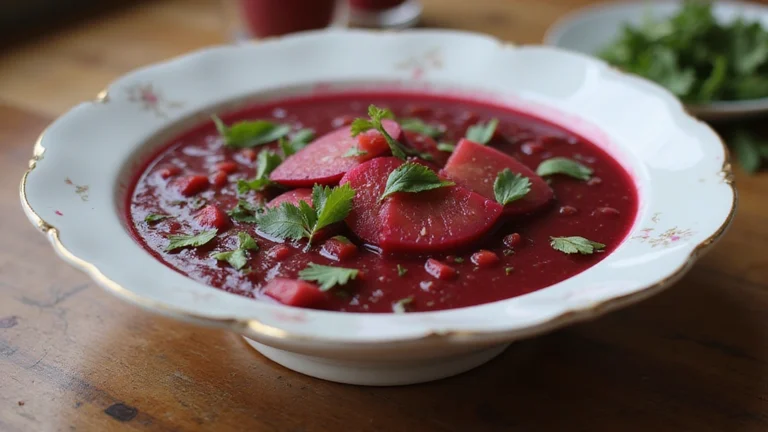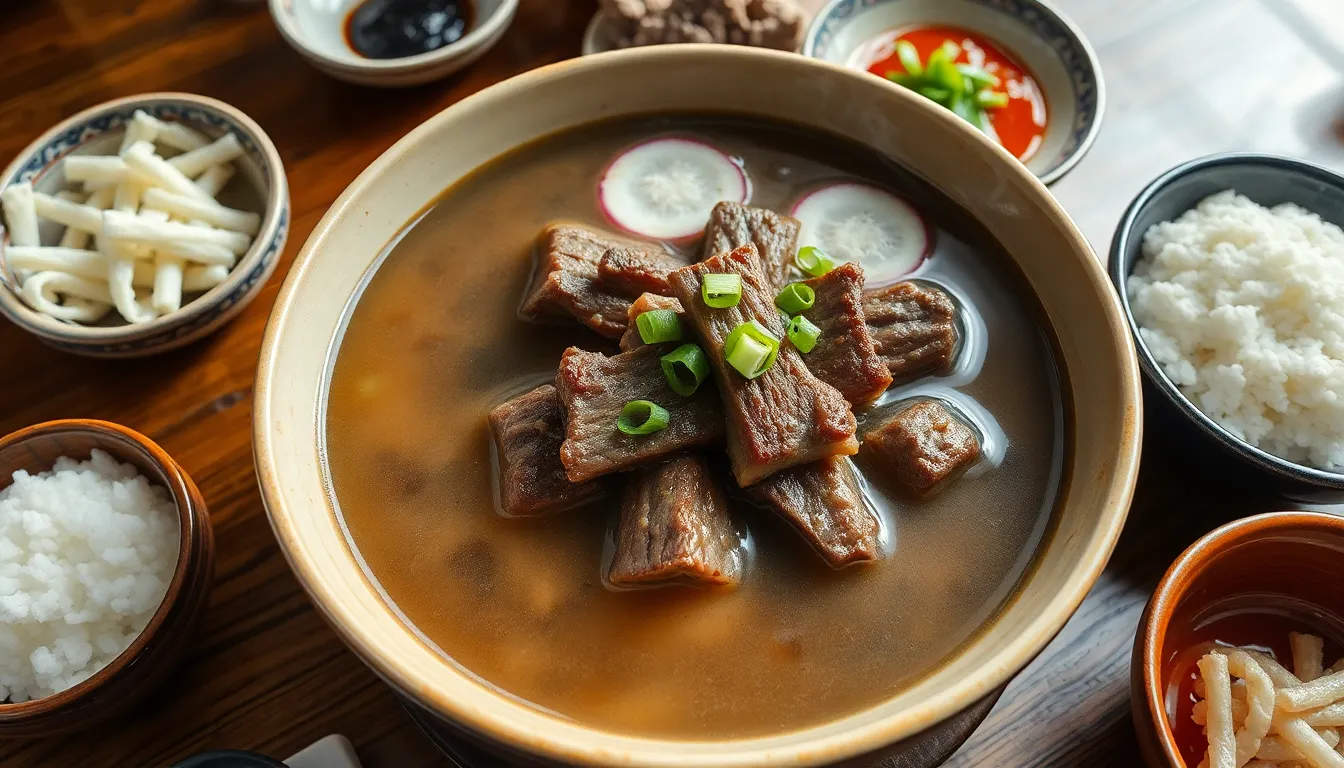
Looking for a shortcut to authentic Korean Galbitang in your Instant Pot? This traditional beef short rib soup typically takes hours to prepare, but with your pressure cooker, you’ll enjoy this rich, flavorful dish in a fraction of the time.
Galbitang (갈비탕) is a beloved Korean comfort food featuring tender beef short ribs simmered in a clear, nourishing broth. The Instant Pot method preserves all the depth and complexity of the traditional recipe while making it accessible for busy weeknights. You’ll love how the meat becomes fall-off-the-bone tender while the broth develops that signature clean, slightly sweet flavor that makes this soup so satisfying year-round.
What Is Galbitang (Korean Beef Short Rib Soup)?
Galbitang (갈비탕) is a beloved Korean soup made with beef short ribs simmered in a clear broth until the meat becomes tender enough to fall off the bone. This traditional dish holds a special place in Korean cuisine and is often served at celebratory events or as a nourishing family meal.
The name “galbitang” combines two Korean words: “galbi” meaning ribs and “tang” meaning soup. Unlike its spicy cousin kimchi jjigae or the robust doenjang jjigae, galbitang features a clean, delicate broth that showcases the natural flavors of beef without overwhelming spices.
What sets galbitang apart from other Korean soups is its focus on premium ingredients. The star component is beef short ribs which release collagen and marrow during cooking, creating a nutritious broth with depth. Traditional preparation requires hours of simmering to extract these flavors, but your Instant Pot dramatically reduces this time without sacrificing quality.
The soup typically includes minimal additions like radish, onions, and garlic which complement rather than compete with the beef flavor. Before serving, the broth is garnished with green onions and sometimes served with a side of salt, pepper, and minced garlic to adjust seasoning according to personal preference.
Korean diners traditionally enjoy galbitang with a bowl of steamed rice and several banchan (side dishes) to create a complete meal. The rich protein from the beef ribs paired with the nourishing broth makes this soup especially popular during cold winter months, though it remains a year-round comfort food for many Korean families.
Why You’ll Love This Instant Pot Galbitang Recipe
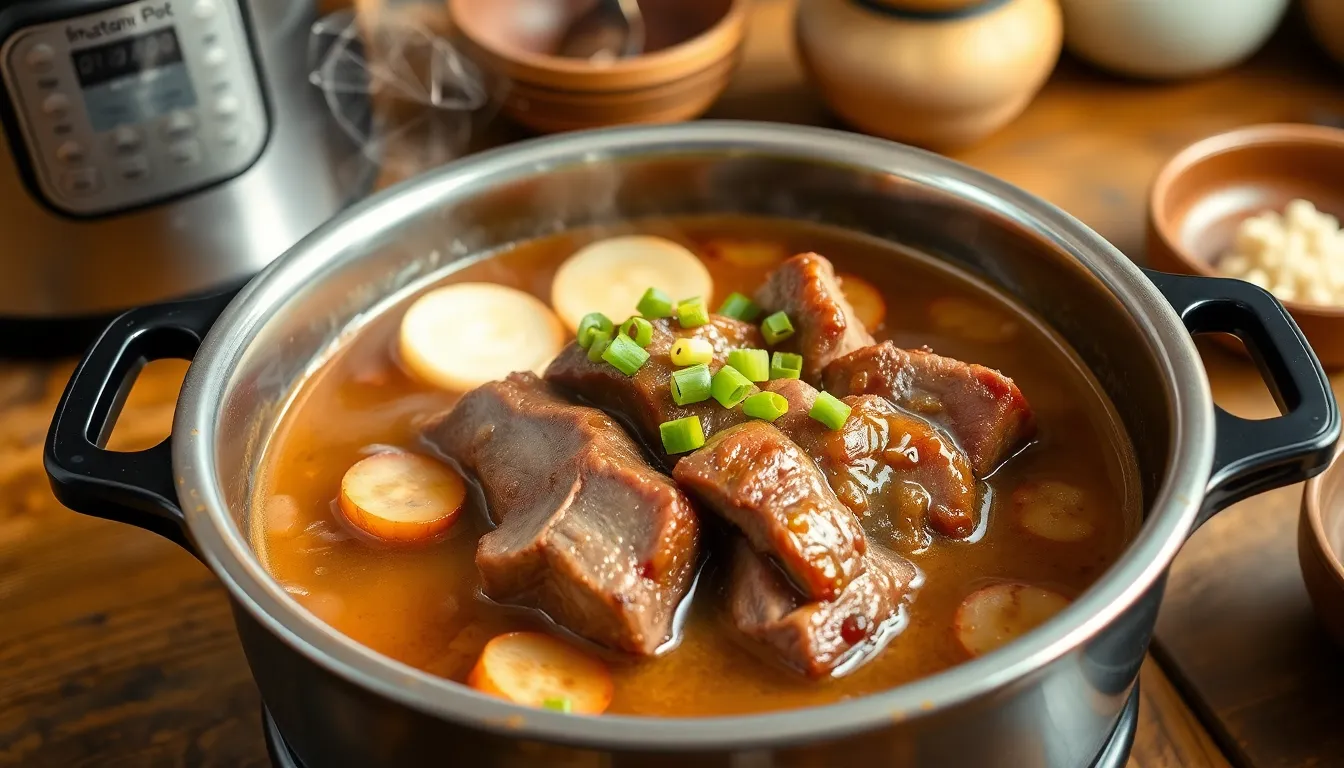
Remarkable Time Savings – Traditional galbitang requires hours of patient simmering to develop its signature flavors. Your Instant Pot transforms this time-intensive process into a quick 30-minute pressure cooking session plus some prep time. Dinner can be ready in under an hour instead of waiting half a day for those tender short ribs.
Crystal Clear Broth – This recipe maintains the authentic clarity of traditional galbitang through a simplified process. You’ll pressure cook the ribs briefly to release blood and fat then rinse away impurities—achieving that pristine broth without the traditional lengthy soaking and parboiling methods.
Simple Yet Flavorful Ingredients – You need only basic components to create this deeply satisfying soup. Beef short ribs form the foundation while Korean radish (or daikon) adds subtle sweetness. Aromatics like garlic onion and ginger infuse the broth with depth without overwhelming the natural beef flavor. Soup soy sauce (guk ganjang) provides the perfect seasoning touch.
Consistent Results Every Time – The sealed environment of your Instant Pot eliminates the guesswork from traditional stovetop methods. Pressure cooking minimizes evaporation and maintains steady temperature creating reliable results with each batch. First-time makers can achieve restaurant-quality galbitang without years of experience.
Fall-Off-The-Bone Texture – Your Instant Pot breaks down the collagen in tough short ribs quickly resulting in meat that effortlessly slides off the bone. This perfect tenderness typically requires hours of traditional cooking but happens remarkably fast under pressure.
Nutrient-Rich Meal – The pressure cooking process extracts maximum nutrients from the bones and meat creating a collagen-rich broth that’s both delicious and nourishing. The soup delivers deep satisfaction without heavy seasonings or additives making it perfect for everyday meals or special occasions.
Ingredients You’ll Need

Creating authentic Instant Pot Galbitang requires exact ingredients to achieve that rich Korean beef short rib soup flavor. The recipe divides into two main component groups that work together to create this traditional dish.
For The Broth
- 3-4 pounds beef short ribs (galbi), cleaned
- 1 medium onion, cut into halves
- 2 large scallions (white parts only)
- 8 garlic cloves or 1 whole garlic bulb, halved
- 1/2 to 1 Korean radish (mu), cut into large chunks (about 300g)
- 2 slices of ginger (about 1 inch thick)
- 8-10 cups water (enough to cover the ribs)
- 1/2 teaspoon whole black peppercorns (optional)
- 2 tablespoons Korean soup soy sauce (guk ganjang)
- Salt and pepper to taste
For The Garnish
- 2-3 scallions, chopped
- Korean glass noodles (dangmyeon), optional, soaked in warm water before use
Kitchen Tools Required
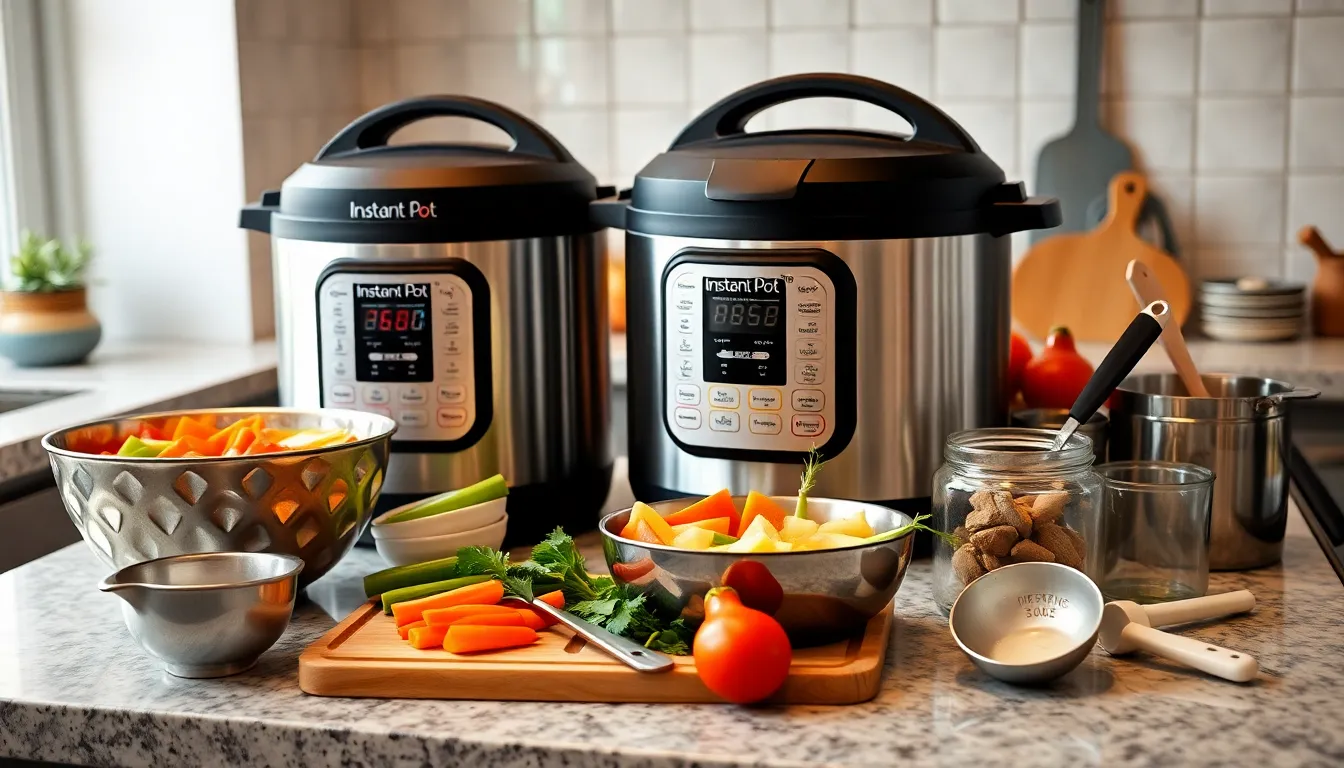
Preparing Galbitang in your Instant Pot requires fewer tools than traditional methods while still delivering authentic results. Here’s what you’ll need to assemble before starting your Korean beef short rib soup:
- Instant Pot or electric pressure cooker – The star tool that transforms hours of simmering into a quick 30-minute cooking process
- Large bowl – For soaking and rinsing the short ribs thoroughly
- Strainer or colander – Essential for draining the parboiled ribs and removing impurities
- Sharp knife and cutting board – For prepping vegetables like Korean radish chunks onions and scallions
- Measuring cups and spoons – To ensure accurate ingredient proportions for a balanced flavor
- Ladle – For serving the finished soup and distributing broth and meat evenly
- Fat separator or skimmer – Helps remove excess fat from the surface of the broth for a cleaner taste
- Tongs – Useful for handling hot ribs when transferring them in and out of the Instant Pot
- Small bowls – For preparing and holding garnishes like chopped scallions
The beauty of making Galbitang in an Instant Pot lies in its simplicity. These basic kitchen tools allow you to achieve restaurant-quality results with minimal equipment. The pressure cooker eliminates the need for multiple pots and long-term monitoring required in traditional methods while still producing that clear delicate broth with perfectly tender beef short ribs.
How To Prepare Short Ribs For Galbitang

Properly preparing your beef short ribs is a crucial first step in creating an authentic galbitang with a clean flavorful broth. The traditional method requires some preparation but your Instant Pot will significantly streamline the process while maintaining the soup’s characteristic clarity.
Cleaning and Soaking
While soaking is optional when using an Instant Pot you’ll achieve a clearer broth if you take this traditional step:
- Place your short ribs in a large bowl and cover completely with cold water
- Allow the ribs to soak for 2-3 hours to draw out blood and impurities
- Change the water once or twice during this period if possible
- Drain the ribs and rinse thoroughly under cold running water
This soaking process helps remove excess blood which contributes to a more pristine final broth. For busy cooks the soaking can be shortened to 30 minutes or even skipped entirely when using the Instant Pot method.
Parboiling for Cleaner Broth
Parboiling is an essential step for galbitang that helps remove impurities and excess fat:
- Place the short ribs in a pot filled with enough water to cover them completely
- Bring the water to a rolling boil over high heat
- Boil the ribs for 5-7 minutes until you see gray foam forming on the surface
- Drain the ribs in a colander and rinse thoroughly under running water
- Use your fingers to rub away any remaining blood or bone fragments
Alternatively the Instant Pot offers a quick parboiling method:
- Add ribs to the Instant Pot with enough water to cover
- Cook under high pressure for just 2 minutes
- Perform a quick release of pressure
- Drain and rinse the ribs thoroughly
- Wipe out the Instant Pot insert before proceeding with the main recipe
This quick pressure method effectively releases blood and fat creating a foundation for a clear delicious broth in significantly less time than traditional methods.
Trimming Excess Fat
For the cleanest broth possible:
- Examine each rib piece after parboiling
- Use a sharp knife to trim visible excess fat from the edges
- Leave some fat intact as it contributes to flavor
- Look for and remove any small bone fragments
Properly cleaned and parboiled short ribs will produce a galbitang with the authentic clean slightly sweet flavor that makes this Korean soup so beloved. The extra effort during preparation ensures your Instant Pot version maintains the traditional qualities of this comforting dish while saving important cooking time.
Instant Pot Galbitang Step-By-Step Instructions
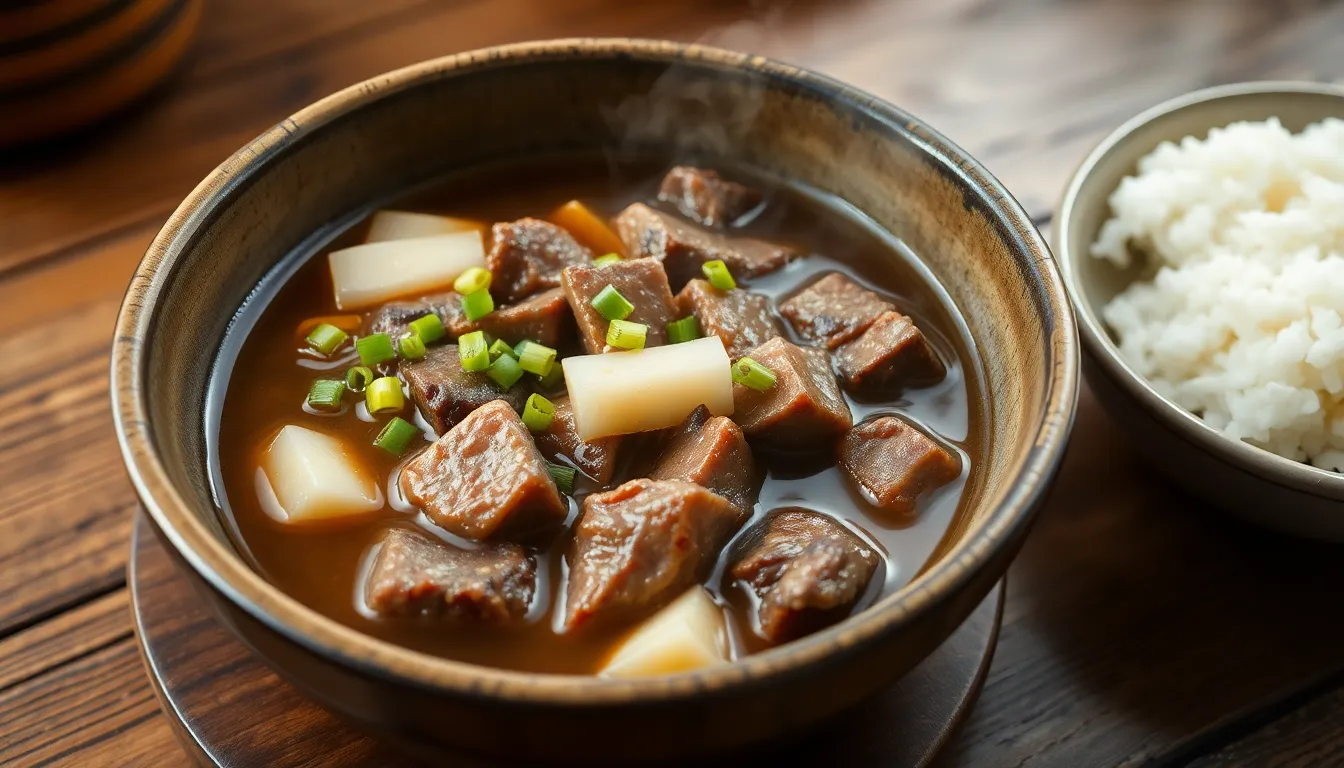
Transform this classic Korean beef short rib soup from an all-day affair into a weeknight wonder with your Instant Pot. Follow these detailed instructions to achieve restaurant-quality galbitang with perfectly tender meat and a clean, flavorful broth.
Parboiling The Ribs
Traditional galbitang preparation requires soaking ribs for hours, but your Instant Pot offers a convenient shortcut. Place your beef short ribs in the Instant Pot and add just enough water to cover them completely. Set the Instant Pot to high pressure for just 2 minutes to release blood and impurities. This quick parboiling method eliminates the need for lengthy soaking while effectively removing elements that could cloud your broth. After the pressure releases, drain the ribs in a colander and rinse them thoroughly under cold water. You should also clean the inner pot to remove any scum or fat deposits that would affect the clarity of your final soup.
Cooking In The Instant Pot
Return your cleaned parboiled ribs to the now-empty Instant Pot. Add aromatic vegetables to build a flavorful foundation – a whole yellow onion with its skin on, several chunks of Korean radish, a few green onions, 4-5 garlic cloves, several slices of fresh ginger, and a tablespoon of whole black peppercorns. Pour approximately 8 cups of water into the pot, ensuring the ingredients are covered but not exceeding the maximum fill line. Secure the lid and set your Instant Pot to the Soup function or Manual High Pressure for 30 minutes if using thinner ribs or 40 minutes for thicker cuts. Once cooking completes, allow natural pressure release for 10 minutes before carefully performing a quick release for any remaining pressure.
Finishing The Soup
Open the lid and carefully remove most of the aromatic vegetables, which have already imparted their flavor to the broth. Keep the radish pieces, cut them into bite-sized chunks, and return them to the soup for texture and flavor. Skim excess fat from the surface using a ladle or fat separator for a cleaner, more refined broth. Season your galbitang with guk ganjang (Korean soup soy sauce) starting with about 2 tablespoons and adjusting to taste. Add salt as needed and a few cloves of minced fresh garlic for brightness and depth. Ladle the hot soup into bowls, making sure each serving includes tender rib meat and radish pieces. Garnish generously with freshly chopped green onions and a sprinkle of freshly ground black pepper. Serve immediately alongside steamed rice and traditional Korean side dishes like kkakdugi (radish kimchi) for an authentic dining experience.
Tips For The Perfect Galbitang
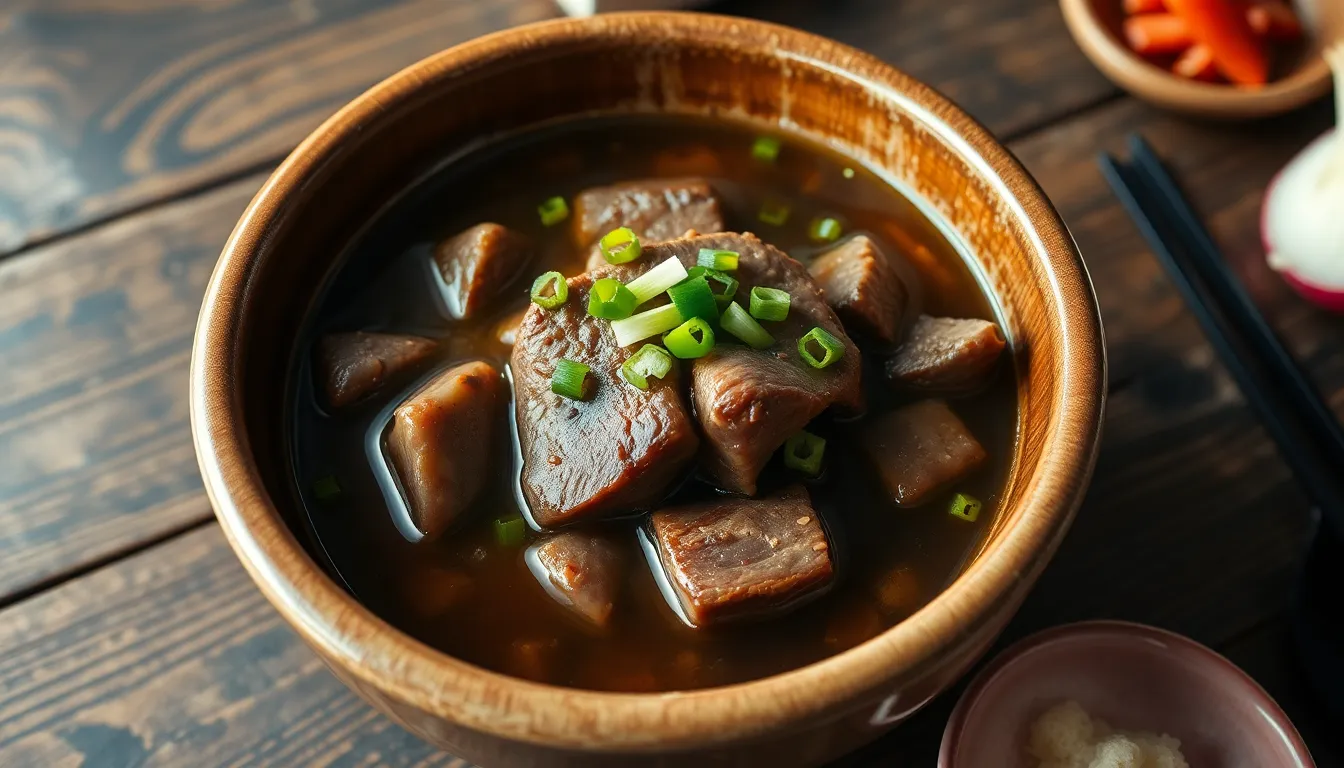
Achieving restaurant-quality galbitang in your Instant Pot requires attention to a few key details that can elevate your soup from good to exceptional. Follow these expert tips to ensure your Korean beef short rib soup turns out perfectly every time.
Skim For Clarity
Remove excess fat after pressure cooking to maintain the signature clear appearance of authentic galbitang. The fat will naturally rise to the top when the soup cools slightly, making it easy to skim off with a spoon or ladle. Using a fat separator can streamline this process and results in a cleaner tasting broth without the greasy mouthfeel that can overpower the delicate beef flavor.
Vegetable Sizing Matters
Cut Korean radish into appropriately sized chunks—about 1.5 to 2 inches—so they cook thoroughly but maintain their shape throughout the pressure cooking process. Smaller pieces might disintegrate completely while larger chunks may remain too firm. Properly sized vegetables absorb the beef flavor while adding their own subtle sweetness to the broth.
Meat Alternatives
Short on beef short ribs? Flank steak makes an excellent substitute in this recipe. While the texture will differ slightly from traditional short ribs, the rich beef flavor still comes through beautifully in the finished soup. Adjust cooking time down by about 5 minutes if using this leaner cut.
Pressure Release Safety
Cover the pressure release valve with a kitchen towel when performing a quick release to prevent hot liquid from splattering around your kitchen. This simple precaution protects both you and your kitchen surfaces from the forceful steam that carries tiny droplets of broth.
Enhance Flavor Depth
Consider saving and reusing the strained cooking liquid from the initial blanching step instead of discarding it. This technique intensifies the beef flavor in your final broth, creating a more robust foundation for your soup. Strain it well to remove any impurities before adding it back to the pot.
Leftover Management
When storing leftovers, refrigerate the soup uncovered until completely cool. A layer of fat will solidify on top, which you can easily remove before reheating. This prevents your reheated galbitang from developing an overly rich or greasy taste profile that wasn’t present in your freshly made soup.
Seasoning Balance
Add salt gradually and taste frequently while seasoning your broth. The Korean soup soy sauce (guk ganjang) already contains salt, so begin with a small amount and adjust according to your preference. Remember that flavors concentrate as the soup sits, so what might seem underseasoned initially could be perfect after resting for a few minutes.
Serving Suggestions
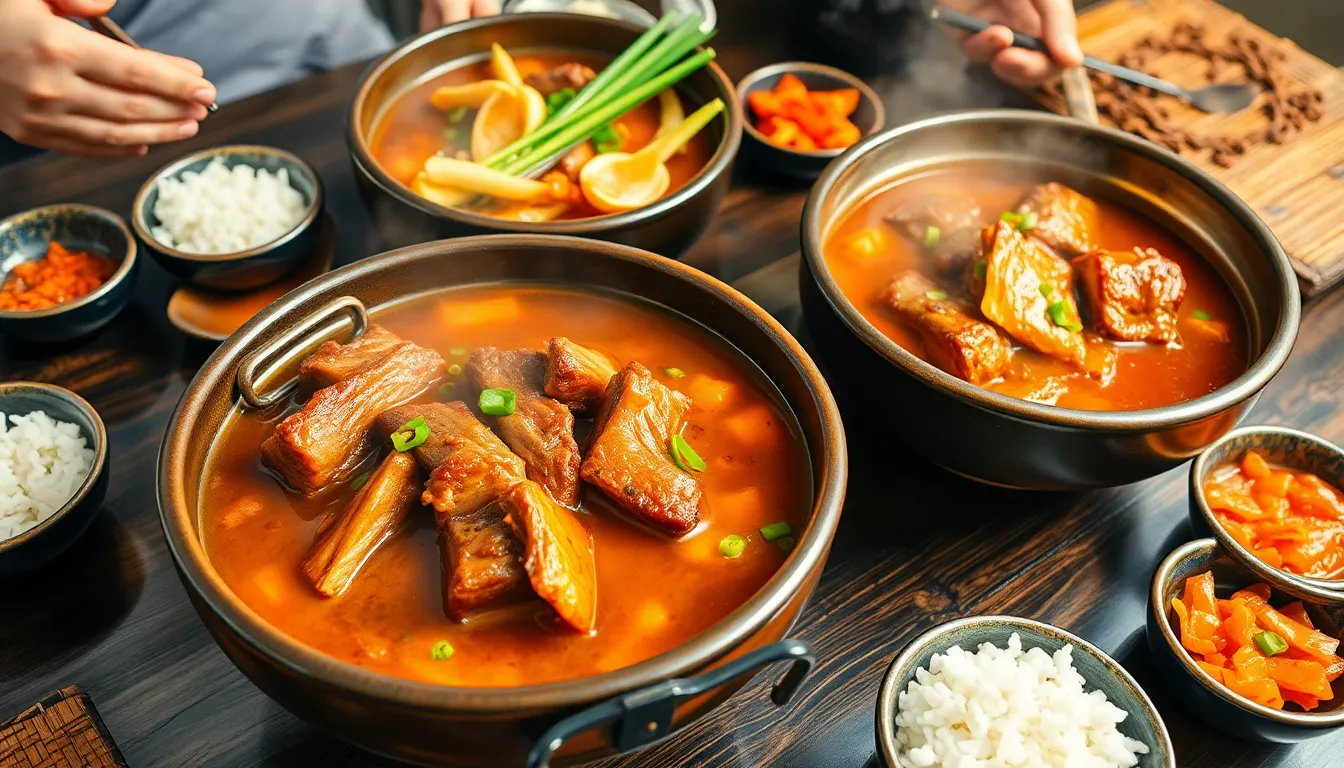
Traditional Korean Galbitang is more than just a soup—it’s a complete meal experience when served properly. Here’s how to present your Instant Pot Galbitang for an authentic Korean dining experience:
Main Presentation
Serve your Galbitang piping hot in large, deep bowls with a generous portion of tender short ribs and chunks of flavorful Korean radish. The clear, nourishing broth should be ladled generously over the meat and vegetables. Each serving bowl should contain at least 2-3 pieces of meat that have been cooked to fall-off-the-bone tenderness.
Essential Accompaniments
Steamed white rice is the traditional partner for Galbitang. Serve it in separate bowls allowing diners to either enjoy it alongside the soup or mix it directly into their broth according to personal preference. The starchy rice creates a wonderful contrast to the savory richness of the soup.
Kimchi provides the perfect tangy counterpoint to the deep flavors of Galbitang. Kkakdugi (cubed radish kimchi) is particularly complementary to this dish with its crunchy texture and spicy profile that cuts through the richness of the beef broth.
Garnishes and Seasonings
Freshly chopped green onions sprinkled over the top add brightness and a pop of color to your Galbitang. Place small dishes of freshly ground black pepper on the table to allow guests to season their soup according to taste.
For those who enjoy additional flavor dimensions, provide small bowls of minced garlic and Korean soup soy sauce (guk ganjang) as optional tableside condiments.
Optional Additions
Korean glass noodles (dangmyun) make an excellent addition for those who prefer a heartier meal. These transparent noodles absorb the flavors of the broth beautifully while adding interesting texture to the dish.
For a complete Korean meal experience, consider serving additional banchan (side dishes) such as seasoned spinach, bean sprouts, or pickled vegetables to create a well-rounded feast that showcases the depth of Korean cuisine.
Seasonal Considerations
While Galbitang is enjoyed year-round in Korea, it makes an especially comforting meal during colder months. During summer, you might serve it with additional fresh vegetables or a cold side dish for balance.
How To Store And Reheat Leftover Galbitang
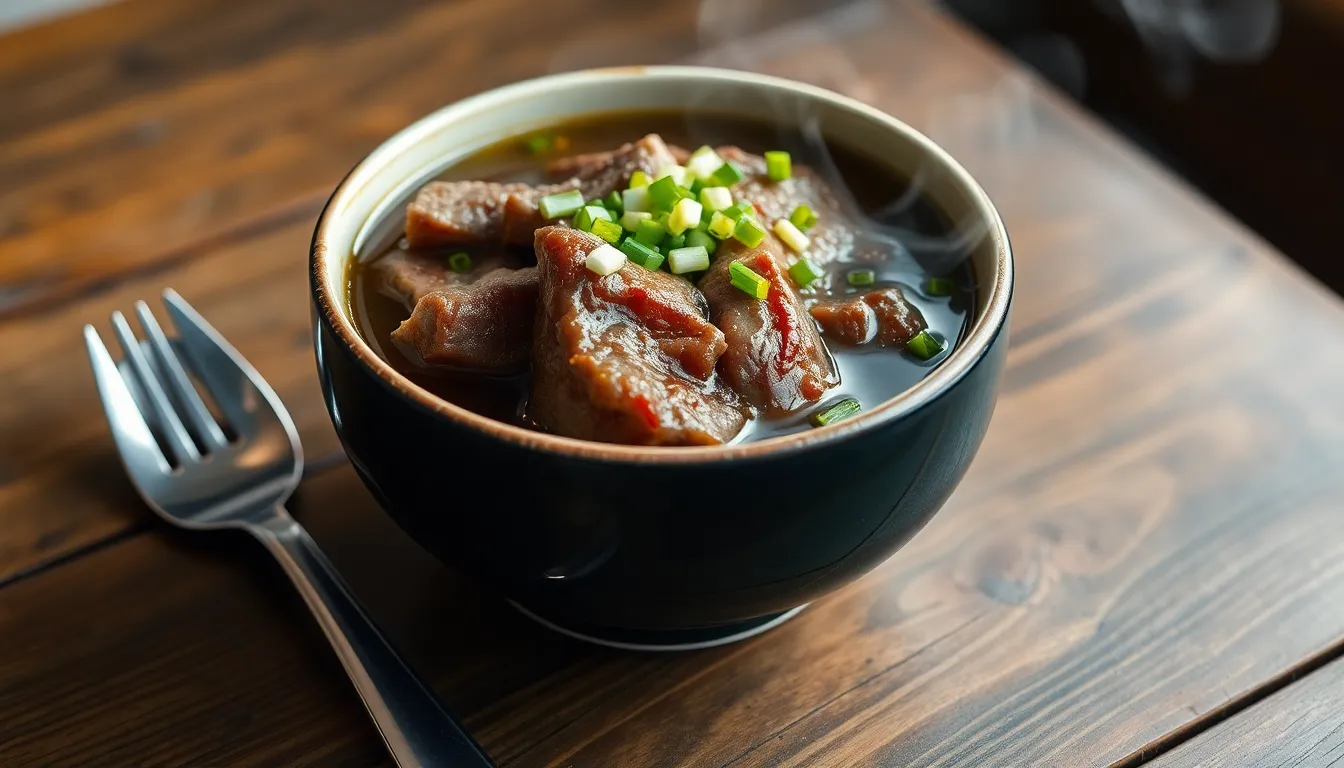
Galbitang tastes even better the next day as flavors continue to develop and meld together. Proper storage and reheating techniques ensure you can enjoy this delicious Korean beef short rib soup for several days after making it.
Storing Leftover Galbitang
Allow your galbitang to cool at room temperature but never leave it out for more than 2 hours to prevent bacterial growth. Transfer cooled soup into airtight containers with secure lids to maintain freshness. Refrigerate leftover galbitang if you plan to consume it within 3-4 days.
For longer preservation, freeze your soup in freezer-safe containers while leaving about an inch of space at the top to allow for expansion as the liquid freezes. Label containers with the date before placing them in the freezer for easy reference later.
Reheating Galbitang
Notice the layer of solidified fat that forms on top of chilled galbitang – this is completely normal. Skim off this excess fat with a spoon before reheating to keep your soup clear and clean in both taste and appearance.
Heat refrigerated galbitang gently on the stovetop over medium-low heat until steaming hot. Alternatively, use your Instant Pot’s “Sauté” or “Keep Warm” function for convenient reheating without additional dishes.
When reheating from frozen, thaw the soup overnight in your refrigerator for best results. Avoid bringing the soup to a vigorous boil during reheating as this can affect the delicate flavor profile that makes galbitang special.
Refresh your reheated galbitang with a sprinkle of freshly chopped green onions and a dash of black pepper just before serving. These simple additions brighten the flavor and enhance the presentation of day-old soup, making it taste almost freshly made.
Traditional Vs. Instant Pot Galbitang
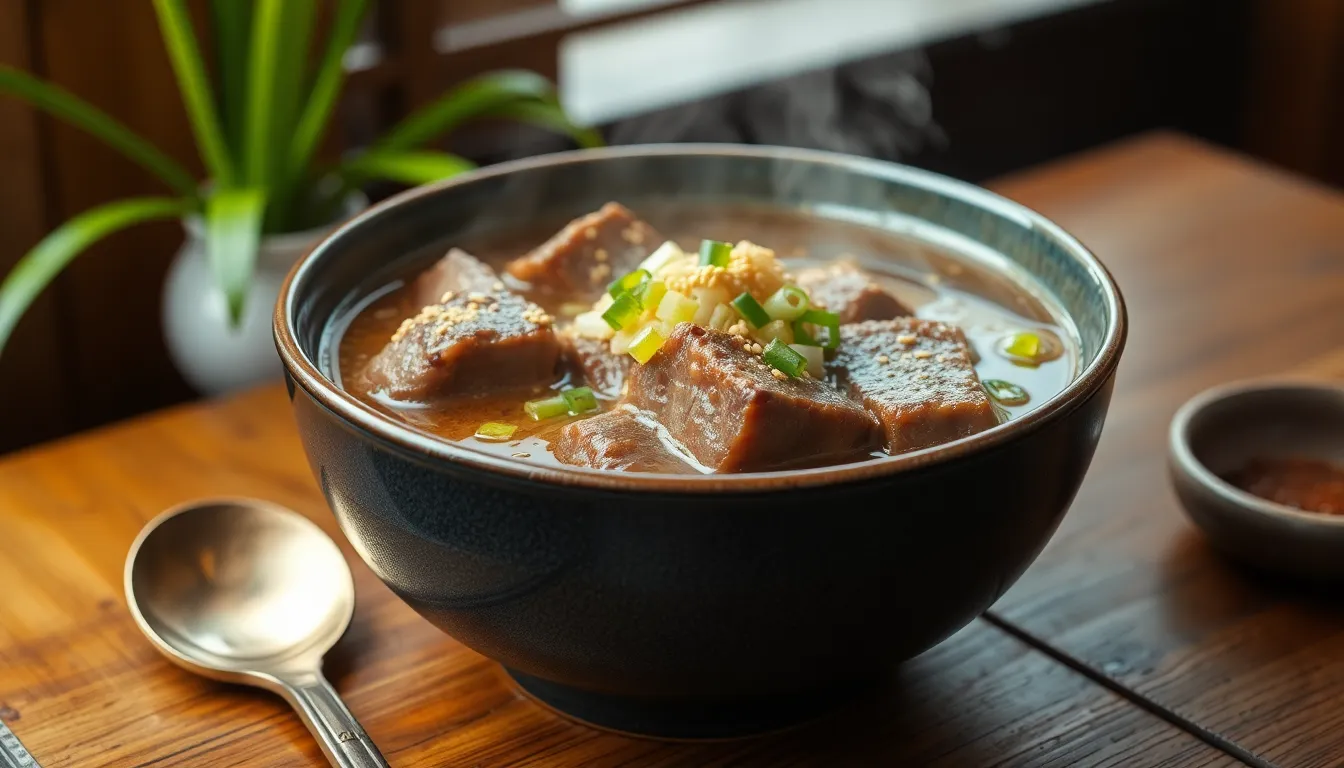
Traditional Galbitang holds a special place in Korean cuisine with its meticulously prepared clear broth and tender short ribs. The conventional cooking method involves several crucial steps to achieve that signature clean taste. First you must soak the beef short ribs in cold water to extract blood and impurities. Next the ribs are blanched in boiling water to remove any remaining residue. After thorough rinsing the meat slowly simmers with aromatic vegetables like Korean radish onion garlic and ginger for several hours until the meat becomes fork-tender.
The Instant Pot approach revolutionizes this time-honored recipe without compromising its authentic flavor profile. Rather than soaking ribs for hours you can briefly pressure cook them for just 2 minutes on high pressure to release blood and fat. This quick parboiling step replaces the traditional long soaking process while achieving similar results. Once cleaned the ribs cook with the same aromatic ingredients but require only about 30 minutes of pressure cooking instead of hours of simmering.
| Aspect | Traditional Galbitang | Instant Pot Galbitang |
|---|---|---|
| Preparation Method | Soak and blanch ribs | Brief pressure cook to release impurities |
| Cooking Time | 3-4 hours | 30-40 minutes |
| Flavor Development | Slow natural extraction | Accelerated extraction under pressure |
| Broth Clarity | Achieved through multiple cleaning steps | Achieved with simplified cleaning process |
| Hands-on Time | Important monitoring required | Minimal supervision needed |
The flavor profile remains remarkably consistent between both methods. Traditional Galbitang develops its depth through long slow simmering which gradually extracts collagen and nutrients from the bones. Instant Pot Galbitang achieves similar richness through high-pressure cooking which forces flavors to infuse more quickly into the broth. Both versions deliver that characteristic clean slightly sweet beef flavor that makes this soup so beloved.
Texture presents another point of comparison between the two cooking methods. Traditional slow-cooked short ribs maintain their structure while becoming tender enough to easily separate from the bone. The pressure cooker version produces exceptionally tender meat that practically falls off the bone sometimes even more readily than the traditional version. Korean radish pieces cook perfectly in both methods absorbing the savory broth while maintaining their distinct texture.
The most important difference lies in convenience and accessibility. Traditional Galbitang requires careful attention and hours of your day making it primarily a weekend or special occasion dish in many households. Instant Pot Galbitang transforms this labor-intensive recipe into an achievable weeknight meal without sacrificing the authentic experience that makes this soup a cornerstone of Korean cuisine.
Customizing Your Galbitang
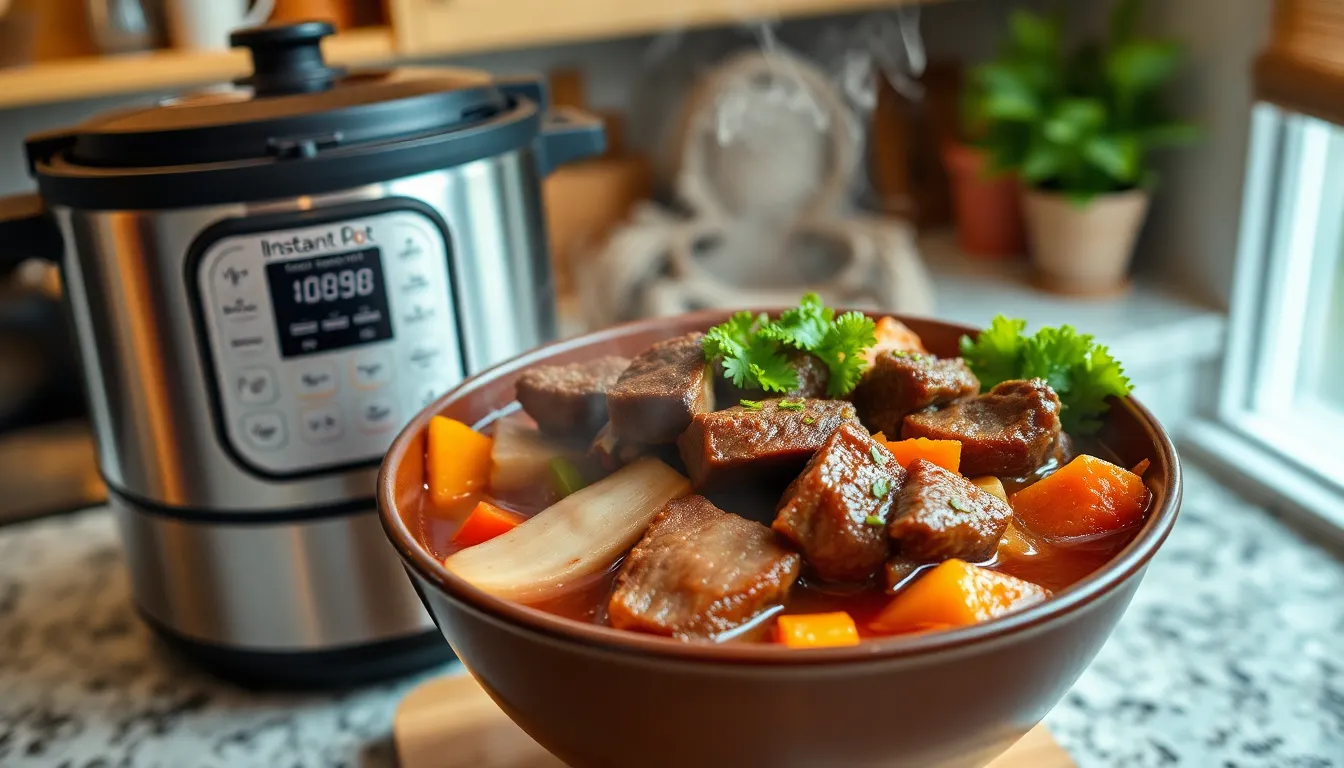
One of the beauties of making Galbitang in your Instant Pot is how easily you can adapt the recipe to suit your preferences while maintaining its authentic essence. These customization options allow you to create a version that perfectly matches your taste preferences or dietary needs.
Protein Variations
While traditional Galbitang calls for beef short ribs, you can experiment with alternative cuts. Flank steak makes an excellent substitute when short ribs aren’t available, offering a leaner option that still provides good flavor to the broth. For a more economical version, try using a combination of beef chuck and marrow bones to achieve that rich flavor profile.
Vegetable Additions
The classic Korean radish (mu) provides a subtle sweetness that balances the rich beef flavor, but you can adjust the chunk size based on your preference. Cut larger pieces for adults who enjoy the vegetable’s texture or smaller chunks for children. Be careful not to dice the radish too small as it may disintegrate during pressure cooking.
Beyond the traditional ingredients, consider adding:
- Carrots for natural sweetness and color
- Korean sweet potato for added heartiness
- Dried shiitake mushrooms for deeper umami notes
- Baby bok choy added after pressure cooking for freshness
Broth Enhancement
Take your Galbitang broth to the next level with these techniques:
- Reuse the strained cooking liquid from the initial blanching process to intensify the beef flavor
- Add a small piece of kelp (dashima) during cooking for natural umami
- Include a tablespoon of dashida (Korean beef stock powder) for enhanced savoriness
- Incorporate soaked dried mushrooms and their soaking liquid for depth
Serving Variations
Customize your finished Galbitang with these serving options:
- For a heartier meal, add pre-soaked Korean glass noodles (dangmyeon) to your bowl
- Create a DIY condiment station with minced garlic, sliced chili peppers, and additional soup soy sauce
- Serve with different kimchi varieties beyond the traditional kkakdugi
- For a modern twist, provide fresh lime wedges for brightness
Spice Level Adjustments
Traditional Galbitang isn’t spicy, but you can adjust the heat level by:
- Adding Korean red pepper flakes (gochugaru) to taste
- Including thinly sliced fresh chilies as a garnish
- Serving with a side of gochujang (Korean chili paste) for those who want more heat
- Using whole black peppercorns during cooking for gentle warmth
Dietary Modifications
Adapt your Galbitang to accommodate dietary preferences:
- For a lower-fat version, cook the soup a day ahead and refrigerate overnight, then remove the solidified fat layer before reheating
- Reduce sodium by using less soup soy sauce and improving with more fresh aromatics
- Create a more concentrated broth by using less water during pressure cooking
- For a fusion twist, finish with a drizzle of sesame oil and sprinkle of toasted sesame seeds
These customization options maintain the soul of traditional Galbitang while allowing you to create a version that perfectly suits your taste preferences and dietary needs.
Health Benefits Of Galbitang
Galbitang offers remarkable nutritional benefits that make it more than just a delicious Korean soup. This traditional dish provides substantial health advantages while satisfying your taste buds.
High in Protein and Collagen: The beef short ribs in galbitang deliver essential protein needed for muscle repair and growth. When pressure cooked in your Instant Pot the bones and connective tissues release abundant collagen which supports joint health and enhances skin elasticity. This natural collagen extraction is one reason galbitang has been valued in Korean culture as a restorative food.
Nutrient-Rich Broth: Your bowl of galbitang contains a wealth of minerals including calcium phosphorus and magnesium that leach from the bones during cooking. These nutrients contribute significantly to bone health and overall wellness. The clear broth remains hydrating and gentle on your digestive system making it suitable for almost anyone.
Low in Fat Content: The traditional preparation method includes skimming excess fat from the surface which results in a relatively low-fat soup. This skimming process creates a lighter meal that satisfies hunger without leaving you feeling heavy or uncomfortable.
Immune System Support: The aromatic ingredients in galbitang provide additional health benefits beyond flavor enhancement. Garlic onion and ginger contain compounds with known immune-boosting and anti-inflammatory properties that help fortify your body’s natural defenses.
Restorative Properties: Koreans have long considered galbitang a healing food particularly beneficial during recovery periods or cold weather. The soup provides warmth and substantial nutrition while placing minimal strain on your digestive system. The Instant Pot method preserves all these health-promoting qualities while making preparation significantly more convenient.
| Nutrient | Health Benefit |
|---|---|
| Protein | Muscle repair and growth |
| Collagen | Joint health and skin elasticity |
| Calcium | Bone strength and development |
| Phosphorus | Energy metabolism and bone formation |
| Magnesium | Muscle and nerve function |
| Compounds from garlic/ginger | Immune support and anti-inflammatory effects |
The pressure cooking function of your Instant Pot ensures maximum extraction of these beneficial nutrients in a fraction of the traditional cooking time. This efficient cooking method breaks down the connective tissues in the short ribs more effectively releasing more of the beneficial compounds while maintaining the authentic flavor profile galbitang is known for.
The Perfect Galbitang For Any Occasion
Your Instant Pot Galbitang journey brings authentic Korean comfort food right to your table with remarkable ease. This time-saving approach delivers all the richness and depth of traditional methods while fitting into your busy lifestyle.
You’ll love how the pressure cooker transforms tough short ribs into tender morsels swimming in a clear nutrient-rich broth. The beauty of this recipe lies in its simplicity – just a handful of ingredients creating something truly special.
Whether you’re serving it for a weeknight dinner or a special celebration the results will impress everyone at your table. So grab your Instant Pot and discover how this centuries-old Korean favorite can become part of your regular cooking repertoire. Your delicious homemade Galbitang awaits!
Frequently Asked Questions
What is Galbitang?
Galbitang (갈비탕) is a traditional Korean soup made with beef short ribs simmered in a clear broth. The name combines “galbi” (ribs) and “tang” (soup). It’s known for its clean, delicate flavor that highlights the natural taste of beef without heavy spices. This premium dish is often served at celebrations and family meals throughout Korea.
How does cooking Galbitang in an Instant Pot save time?
The Instant Pot method reduces cooking time from 3-4 hours to just 30-40 minutes of pressure cooking. This remarkable time savings doesn’t compromise flavor or texture. You’ll still achieve fall-off-the-bone tender meat and a rich, clear broth, but without the traditional hours-long simmering process.
What ingredients do I need for Instant Pot Galbitang?
You’ll need 3-4 pounds of beef short ribs, medium onion, scallions, garlic, Korean radish, ginger, water, black peppercorns, Korean soup soy sauce, and salt and pepper. For garnish, use chopped scallions and optional Korean glass noodles. These simple ingredients create an authentic flavor profile without overwhelming the natural beef taste.
Do I need to soak the beef ribs before cooking?
While traditional recipes require soaking ribs for 2-3 hours to remove blood and impurities, the Instant Pot method makes this step optional. A quick parboiling for 2 minutes in the Instant Pot efficiently removes impurities, saving considerable preparation time while still achieving a clean, clear broth.
How do I get a clear broth for my Galbitang?
For a clear broth, parboil the ribs for 2 minutes in the Instant Pot, then discard this water and rinse the ribs thoroughly. During final cooking, skim off any foam that rises to the surface. After cooking, use a fat separator or chill the soup slightly to remove excess fat that clouds the broth.
Can I use different cuts of beef for this recipe?
Yes, you can substitute flank steak for short ribs, or use a combination of beef chuck and marrow bones. Each alternative will provide a different texture but similar flavor profile. Remember to adjust cooking times accordingly—tougher cuts require the full cooking time, while leaner cuts may need less.
How should I store leftover Galbitang?
Allow leftovers to cool at room temperature for no more than 2 hours, then transfer to airtight containers. Refrigerate for up to 3-4 days or freeze for 2-3 months. The flavors actually improve with time. When reheating, skim off solidified fat and warm gently to preserve the delicate flavor.
What should I serve with Galbitang?
Serve Galbitang hot in deep bowls with steamed white rice and kimchi (particularly kkakdugi radish kimchi). Add freshly chopped green onions on top and offer optional condiments like minced garlic and Korean soup soy sauce. For a complete Korean meal, include additional banchan (side dishes) such as seasoned spinach or pickled vegetables.
Is Galbitang healthy?
Yes, Galbitang is both delicious and nutritious. It’s high in protein and collagen, which supports muscle repair, joint health, and skin elasticity. The broth contains essential minerals like calcium, phosphorus, and magnesium for bone health. Ingredients like garlic, onion, and ginger provide immune-boosting properties, making this a restorative, wholesome meal.
Can I make this recipe without an Instant Pot?
Absolutely. Without an Instant Pot, use the traditional stovetop method: soak ribs for 2-3 hours, blanch them briefly, then simmer in fresh water with aromatics for 3-4 hours until the meat is tender. The flavor will be comparable, though the cooking process requires more time and attention to maintain a gentle simmer.

